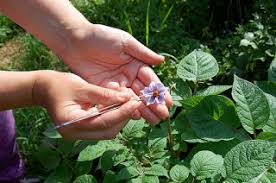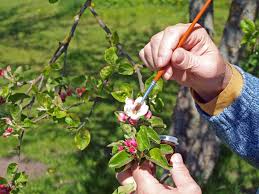Pollination is the transfer of pollen grains from the open anthers to the stigma of a flower. When the pollen grains fall onto the stigma of the same flower, the plant is said to be self-pollinated.
Methods of Breeding Self-Pollinated Crops in Agriculture
Breeding self-pollinated crops involves growing a crop in an environment where it did not originate. For instance, crops such as tobacco, potato, and maize were introduced to Asia only a few decades ago from America. Similarly, crops like cocoa, rubber, tomatoes, maize, and rice were introduced to Nigeria from other countries.
For a successful introduction program, the breeder must have good knowledge and collection of diverse genotypes of a species that can be used as source material for desirable genes and traits. The germplasm collection should include local and exotic strains of the plants and their related species.
Selection Methods for Breeding Self-Pollinated Crops
Selection involves sorting out from a mixed population a plant or a group of plants with desired characteristics. Selection can be natural or artificial and is only possible when there are variations. Two types of selection are often practiced in breeding self-pollinated plants: mass selection and pure line selection.
Read Also: 6 Ways to Enhance Egg Production and Maximize Profits on Poultry
Mass Selection in Self-Pollinated Crops

In mass selection, plants are chosen based on their phenotypes, and their seeds are composited without progeny testing. During mass selection, a few or several hundred plants with similar phenotypes are selected in the first year, and their seeds are composited.
These seeds are grown in the second year for a preliminary yield test, and their performance is compared with the standard varieties. This procedure is repeated in subsequent years (up to the seventh year). In later years, seed multiplication and commercial distribution are carried out.
This method of selection has two major limitations. Since selection is done based on phenotypic appearance, sometimes homozygous and heterozygous plants are mixed together, and the heterozygous ones segregate in later generations. Additionally, hereditary and environmental variations are not distinguished during selection.
Pure Line Selection in Self-Pollinated Crops
A pure line refers to a collection of plants from a single homozygous individual, resulting from self-pollination. In pure line selection, up to 1,000 plants are selected from a genetically mixed population of a particular variety in the first year.
In the second year, the progeny of each plant are grown in separate rows, and seeds of superior plants within each row are composited to form experimental strains.
For the next five years, different strains are grown in replicated plots, with superior strains selected and their yields compared. In the eighth year, the best strain is multiplied for commercial distribution.
Varieties developed by pure line selection are often more homozygous genetically than those developed by mass selection. However, once a pure line is established, no further selection is needed. Results from several studies have shown that variations observed between pure lines are environmental.
This method does not create new genotypes, as selection is limited to the isolation of the best genotype within a population. Pure line selection thus narrows the genetic base, which can be undesirable because genetic variability is essential for adaptation to various environmental conditions.
Read Also : How to Plant Fruit Trees for Optimum Performance
Hybridization in Breeding Self-Pollinated Crops

Hybridization is the process of producing an individual from the union of gametes from genetically different parents. This involves crossing different plants, combining or transferring desirable traits from two or more species, varieties, or lines.
Artificial crossing is necessary for hybridizing self-pollinated plants and involves removing the anther before it dehisces and collecting and transferring pollen from the male parent to the stigma of the emasculated plant.
Cross-fertilization results in heterozygous progeny, but in subsequent generations, the percentage of homozygosity increases due to self-fertilization. To achieve a wider range of genetic segregation, a large number (about 10,000) of the F2 progeny are selected using pedigree selection or bulk population methods.
In pedigree selection, plants with desirable genotypes are selected from the segregants in the second and subsequent generations until genetic purity is reached.
In the bulk population method, selection is delayed until later generations (the fifth and sixth), where segregation and variation in the population are abundant. At this stage, most of the plants become homozygous and breed true.
When a few simply inherited characters are to be transferred, repeated back-crosses are made with the parent possessing most of the desired traits. A series of such crosses can be illustrated as follows:
A X B → B X C → B X D → B X E → B X F
C → D → E → F → G
Here, parent A is the non-recurrent parent, while B is the recurrent parent. The offspring contain most of the genes and traits of the recurrent parent. In the recurrent back-cross method, selection is necessary after each cross, and the desirable hybrids are back-crossed to the recurrent parent.
Hybridization combines genes from many strains, generating significant variations, some of which may prove useful.
Introduction, selection, and hybridization are essential methods of breeding self-pollinated plants. In self-pollination, pollen is transferred from the stamens to the pistil within one flower. The resulting seeds and plants they produce inherit genetic information from only one parent, making the new plants genetically identical to the parent.
The advantages of self-pollination include the assurance of seed production when no pollinators are present and the potential for rapid propagation. Weeds, for instance, typically self-pollinate, enabling them to produce an entire population from a single plant.
However, the primary disadvantage is genetic uniformity, making the population vulnerable to extinction by a single disease to which all plants are equally susceptible.
Furthermore, beneficial genes spread more slowly compared to cross-pollination, as a plant with a beneficial gene can only pass it on to its offspring. Self-pollination likely evolved as a survival mechanism in harsh environments where pollinators were scarce.
For pollination to be successful, pollen must be transferred between plants of the same species. For example, a rose flower must receive rose pollen, and a pine tree must receive pine pollen. Plants typically rely on either cross-pollination or self-pollination, although some species are capable of both.
Do you have any questions, suggestions, or contributions? If so, please feel free to use the comment box below to share your thoughts. We also encourage you to kindly share this information with others who might benefit from it. Since we can’t reach everyone at once, we truly appreciate your help in spreading the word. Thank you so much for your support and for sharing!

